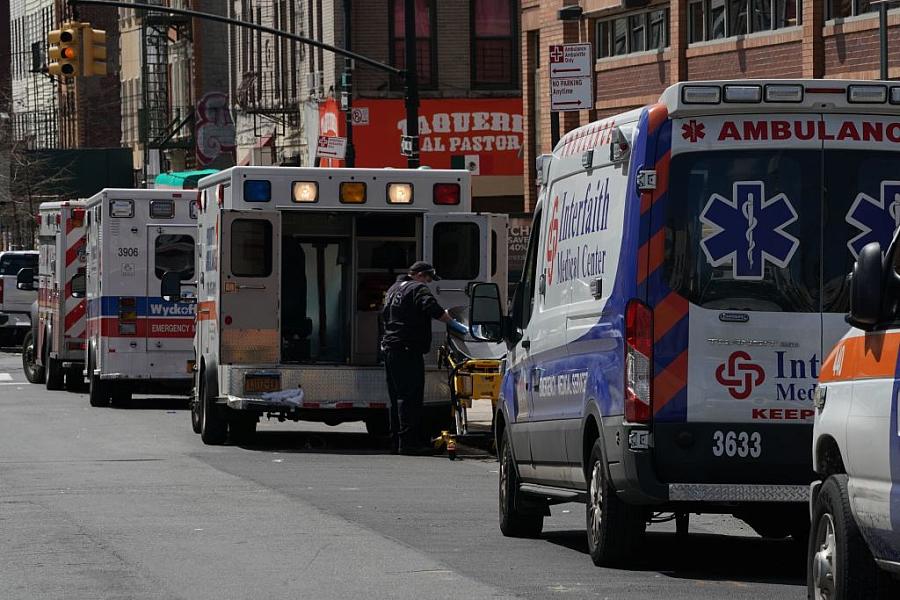Reporters pushing for answers as COVID-19 numbers climb

Ambulances parked outside of Wyckoff Hospital in Brooklyn on April 4.
(Photo by Bryan R. Smith/AFP via Getty Images)
Reporters have been asking good questions about whether their communities are ready for the expected surge of patients suffering from COVID-19.
I’m going to highlight some good examples below.
In Santa Cruz County, at television station KSBW, reporter Christopher Salas check in with Santa Cruz Health Officer Dr. Gail Newel to find out if the county was ready for the surge expected in the state of California around mid-April.
“Newel said the county is already preparing to put beds at two alternative care sites: Simpkins Family Swim Center and an undisclosed location. She said with those two locations and the mobile hospital they will be able to add 180 more hospital beds to the capacity of the three county hospitals.”
The next step would be to see how that is actually playing out. Call the Swim Center. Demand to find out about the undisclosed location. How exactly are beds being added? Will they be enough?
In Connecticut, Len Besthoff at NBC station CT reported that by the time the peak impact of the virus is expected to hit in that state in mid-April, “state hospitals will need about 3,300 beds, but only have roughly 1,700 beds, about half of what is needed.”
Besthoff talked to a large health care provider in the state, Hartford HealthCare, to find out what they were doing about the shortage. The vague response was also something that reporter should truth-check later.
“With all the work we are doing working with our community teams, working with our hotels, working with Trinity College, that is why we’re preparing for that, so we’re preparing for the high end of the stress at this time,” Dr. Ajay Kumar, executive vice president and chief clinical officer, told Besthoff.
Call Trinity College. Call local hotels. Find out what is really going on.
One can never know exactly what drives policy decisions in different states, and governors are loathe to give reporters credit. But I think we are starting to see an impact from stories calling out the expected shortages in hospital resources. The Miami Herald’s David Smiley and Mary Ellen Klas called out Gov. Ron DeSantis for being slow to act to enforce social distancing statewide. On March 31, they wrote:
DeSantis, who says he is in daily contact with President Donald Trump, has spoken about coronavirus infections with an emphasis on current data, as opposed to future projections. In choosing not to issue a statewide stay-at-home order, as more than 20 other governors have done, he has said it would be counterproductive to shut down parts of the state with only a few confirmed coronavirus cases.
Three days later, and one day after there were 77 deaths reported in a single day, the governor issued a stay at home order.
The other thing the Miami Herald did that other reporters should be doing is demanding to know how decisions were being made by state leaders. It has kept pushing the DeSantis administration for explanations.
DeSantis’ administration has so far refused to identify or release any information about how it is using projections to guide forward-thinking decisions that epidemiologists say should be aimed at addressing infections that will likely lead to consequences weeks after they first occur.
The public should know whether the government officials charged with marshalling the right resources to save lives from this pandemic are making decisions driven by the best available information and sound reasoning. If something doesn’t make sense to you about how an agency is handling the crisis, you might want to act on your suspicions. People will make errors during the pandemic, and some of that is to be expected, given the fast-moving nature and many unknowns surrounding the virus.
At the same time, there are basic elements to crises like these that are tried-and-true public health approaches, things that have already been shown to work in places such as South Korea — or even look at the contrast between what is happening in California versus other states that waited longer to implement social distancing.
So ask those questions of the people in charge of protecting the public’s health: How did you make that decision and why?

